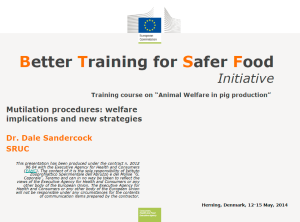Temporal changes in mechanical nociceptive thresholds in juvenile pigs subjected to surgical tail amputation: a model of injury induced by tail biting. By Di Giminiani, P., E. Malcolm, M. Leach, M. Herskin, D. Sandercock, S. Edwards, 2016. Royal Dublin Society: Abstracts book of the 24th International Pig Veterinary Society (IPVS) Congress, Dublin, Republic of Ireland 7-10th June 2016. p. 649.
Abstract
Introduction: Tail biting is a global welfare problem in the pig industry leading to significant tail injury and potential carcass rejection. The temporal effects of such injuries and subsequent healing are presently unknown, although limb amputation in humans can lead to abnormal neural activity and decreased nociceptive thresholds. In order to evaluate potential sensitisation following tail damage, we created a model by surgical amputation of tails, and assessed mechanical nociceptive thresholds.
Materials and Methods: Surgical tail resection was performed to assess the influence of age, extent of tail amputated and time since amputation on thresholds of mechanical nociception. To evaluate the effect of age at the time of injury, female pigs underwent surgery at 9 weeks (±3 days ‘weaner’) (n=19) or 17 weeks (±3 days ‘finisher’) (n=43). The effect of time after amputation was evaluated on 24 pigs at 8 weeks, and 38 pigs at 16 weeks after surgery. The effect of the extent of tail amputated was assessed by assigning the pigs to 3 treatments (‘Intact’: sham-amputation; ‘short tail’: 2/3 of tail removed; ‘long tail’: 1/3 of tail removed). A Pressure Application Measurement device was used to record mechanical nociceptive thresholds (tail flick or tail clamp withdrawal responses). Within a single session, three stimuli were applied to a skin area proximal to the site of amputation, 3 days pre-surgery, 1 week and either 8 or 16 weeks post-amputation.
Results: Across the two amputation ages, results indicated that tail amputation induced a significant reduction (P<0.05) in mechanical nociceptive thresholds in short and long tails one week after surgery. The same treatment effect was observed at 16 weeks after amputation performed at 9 weeks of age (P<0.05). For surgeries performed at 17 weeks of age, thresholds tended to be lower in short compared to intact tails (P=0.081) and significantly lower (P<0.05) in long tail pigs 8 weeks after amputation. No significant difference was observed at 16 weeks following surgeries performed at 17 weeks of age.
Conclusion: These results show that surgical amputation of pig tails leads to decreased cutaneous mechanical nociceptive thresholds in the skin area proximal to the site of injury. Results indicated that severe tail injury occurring in the weaner period may be associated with sensitisation up to 16 weeks following the injury. In contrast, injuries occurring in the finishing period appeared to be associated with shorter lasting mechanical sensitisation, resolving within 16 weeks.



